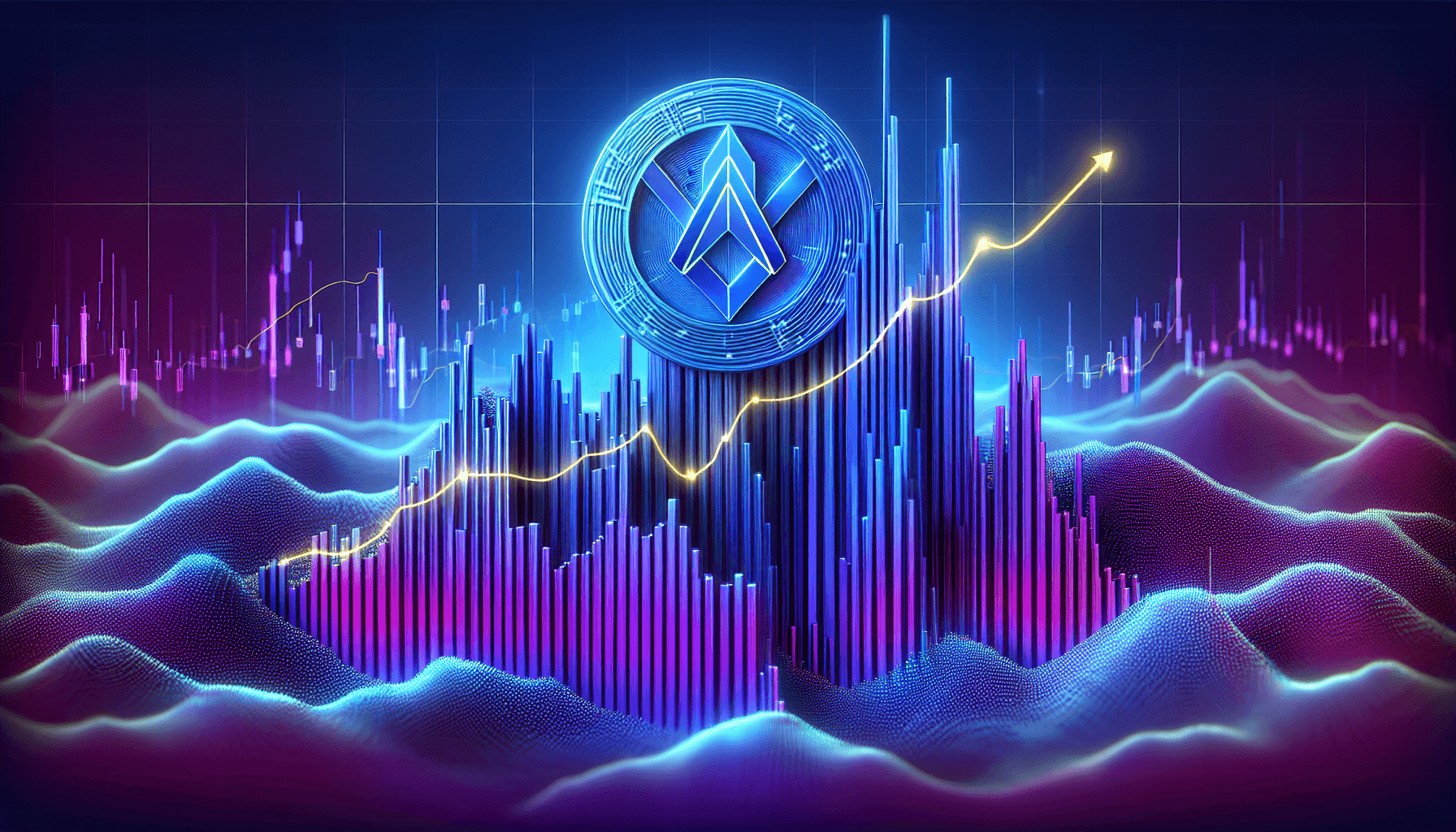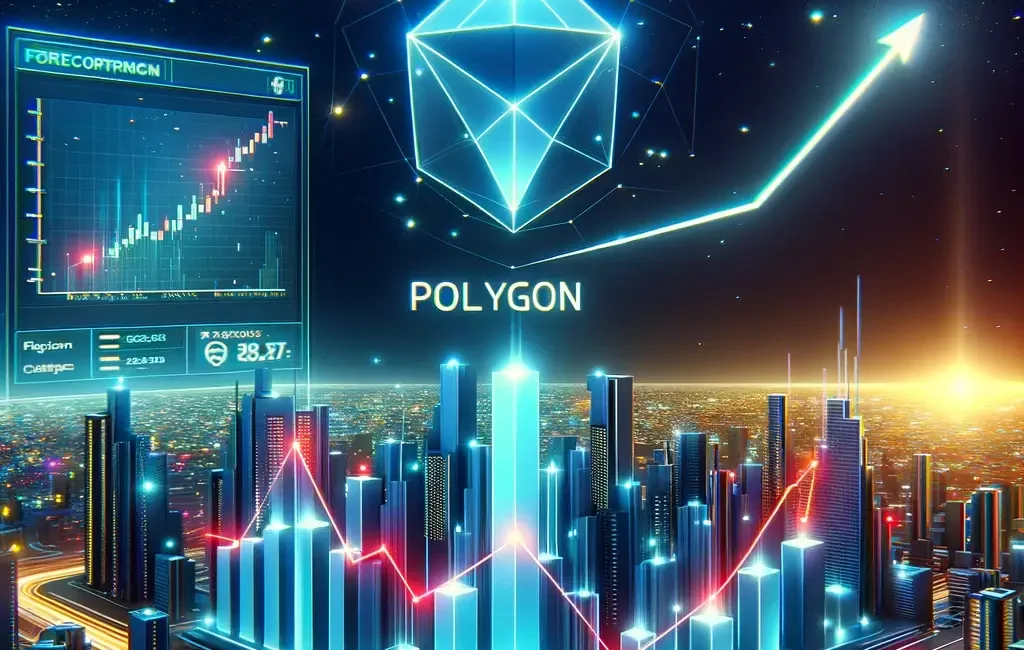Forecasting the ‘polygon price prediction’ is a complex endeavor. This article strips away fluff to offer a pragmatic viewpoint on MATIC’s price from 2024 to 2030. We map out the key factors impacting Polygon’s trajectory by weaving past performance with technical analysis and expert opinions.
Steer clear of sugarcoating and brace for a no-nonsense approach to understanding Polygon’s potential market position.
Key Takeaways
- Polygon’s (MATIC) growth is driven by its innovative protocol suite aimed at solving Ethereum’s high fees and scalability issues. Its native token is central to network transactions and governance.
- MATIC’s price has experienced significant volatility, with its past performance influenced by market trends, technical developments, and a fluctuating cryptocurrency market, leading to a varied sentiment among investors.
- Investing in Polygon requires a strategy incorporating risk management, diversification, and staying abreast of market and network developments to mitigate volatility and potential risks.
Polygon (MATIC) Overview

Launched in 2017 by Jaynti Kanani, Sandeep Nailwal, and Anurag Arjun, Polygon was initially known as Matic Network. The rebranding to Polygon was more than just a name change; it was a vision to solve some of the most pressing issues in the Ethereum network, such as high transaction fees everywhere, poor scalability issues, and slow transaction speeds.
Polygon’s native currency, the MATIC token, holds a significant position within the polygon network. As an ERC-20 token, MATIC is used for transactions, transaction fees, and network governance through a proof-of-stake consensus mechanism. This governance token means that holders of MATIC tokens have a say in managing the Polygon network, giving them a stake in its future.
However, Polygon is not content with its achievements. The team is actively developing Polygon 2.0, a protocol suite similar to the Internet protocol suite. It features different layers, such as:
- The Staking layer
- The Aggregation layer
- The Execution layer
- The Proving layer
These layers aim to provide unlimited scalability and unified liquidity. This innovative approach makes Polygon an exciting player in the crypto market.
Past Performance MATIC Analysis

The price history of Polygon’s MATIC token reveals a journey of peaks and valleys. From an all-time low of $0.0032210 in May 2019 to an all-time high of €2.71, the token’s performance has been a rollercoaster ride. In 2019, the token saw a low of $0.0030 and rallied to a peak of $0.0450, averaging $0.0158 for the year.
In 2020, the minimum price of polygon tokens in polygon price forecast prediction varied from $0.0070 to $0.0324, and a significant minimum polygon price move in polygon price prediction of $0.0173 was recorded in 2021. Despite these fluctuations, it’s notable that Polygon’s market capitalization is a substantial $8,176,296,137, placing it among the top 10 cryptocurrencies on CoinMarketCap. However, the current minimum price in the polygon price forecast prediction made for Polygon in the forecast will change as the market evolves.
That being said, the past year has been a challenging one for MATIC. The token witnessed a decline of -36.18%, reflecting a period of negative growth in total supply and trading volume. A key challenge for MATIC remains to achieve and sustain pivotal price points such as resistance levels, such as the $1 threshold, which signifies the maximum level of market confidence and investor interest.
Factors Influencing Polygon’s Price
The price of Polygon’s MATIC token isn’t immune to the whims of market trends. Bull runs, market corrections, and even the psychology of users play a significant role in influencing the token’s current price move. The current sentiment towards MATIC is bullish, as indicated by a high Fear & Greed Index.
On the technology front, Polygon’s price is influenced by advancements such as the introduction of new scaling solutions and network upgrades and enhancements. For example, the launch of AggLayer V1 and the network’s positioning in DeFi with zkEVM Validium L2 have influenced MATIC’s price.
Regulatory changes also impact the price of MATIC. The factors that can affect the cost of MATIC include:
- U.S. regulators’ approval of Bitcoin ETFs can set market precedents that positively affect cryptocurrencies like Polygon’s MATIC.
- The adoption of Polygon is evidenced by its rising user addresses and solid user base performance.
- The overall growth of the blockchain and cryptocurrency sectors.
All of these factors contribute to MATIC’s price appreciation.
Technical Analysis Plygon and Matic Price Predictions

Technical analysis is an invaluable tool for many traders when predicting future prices. By examining the relative strength index of the following indicators, we can gain insights into potential future price movements and trends for MATIC:
- Chart patterns
- Oscillators
- Moving averages
- Historical price movements (in place of “Historical data”)
Polygon Price Prediction 2024
As we look towards 2024, price predictions for Polygon’s MATIC token range from a minimum price prediction of $0.6 to a maximum price prediction of $1.57, with an average trading-in price prediction 2024 of $1.13. These predictions are based on current market trends, technical indicators, and the broader cryptocurrency market’s performance, including the price of Polygon and the Matic coin market price.
It’s essential to remember that these are simply predictions by market analysts. While some experts predict a bullish market sentiment that could see the market cap of MATIC reaching a value of $1.63, others, like WalletInvestor, adopt a bearish stance, forecasting a possible decrease to $0.6, all of which can impact the market cap.
Polygon Price Prediction 2025
Fast forward to 2025, and the predictions for a maximum price and average trading price for MATIC become even more enjoyable. The token’s maximum price is predicted to range between $1.62 and $2.25, with an above-average trading price used in price prediction of $1.67. This average price and the price forecast indicate a potential for steady growth in the token’s value.
Some forecasts, however, are even more optimistic. Specific price projections indicate a potential rise of up to $3.25, while the average, minimum, and maximum price amounts might differ. But as always, these are just predictions and should be taken with a grain of salt, considering that both minimum and maximum prices, average prices, and minimum and maximum prices can vary.
Polygon Price Forecast 2026–2030
Looking further into the future, the magic of magic matic price and prediction from 2026 to 2030 suggests steady growth. Here are the yearly low and average price of Matic price for thematic price and the price of magic and price prediction, and the same minimum price and maximum prices for matic price prediction predictions:
- 2026: $0.907181
- 2027: $2.34
- 2028: $4.56
- 2029: $7.89
- 2030: $10.43
The potential highs are even more bullish and signal exciting, with forecasts suggesting potential highs of $4.33 for 2026 and up to $13.72 by 2030. The average trading price for MATIC is expected to be approximately $2.41 in 2026, progressing to around $10.73 by 2030.
This bullish momentum reflects a consensus on the token’s steady growth, painting a promising picture of MATIC’s future and the price of magic and price trajectory.
Expert Opinions on Polygon’s Future

Experts have varying opinions on predicting the future of the magic price prediction of Polygon. Some predict bullish growth, while others foresee potential declines.
However, they all agree on one thing: the exact Polygon’s magic price in action and current polygon price, matic price prediction and prediction for the next polygon price, and Matic price prediction forecast for Polygon aims in the year 2025 and beyond are challenging to predict due to the speculative nature of cryptocurrency markets, making the Polygon matic price prediction and polygon price prediction and forecast uncertain.
The future potential and adoption of Polygon are highly dependent on the direction and performance of the broader crypto industry. Factors such as market trends, technological advancements, and regulatory changes all play a role in influencing Polygon’s following polygon price analysis and prediction and MATIC’s future polygon price analysis and prediction.
Therefore, before investing in Polygon, investors are advised to undertake their research through comprehensive personal analysis, including their research and Polygon’s own research and price analysis. This will ensure that they make informed investment decisions by Polygon based on their research, study their research, risk tolerance, and investment goals rather than relying solely on expert opinions.
Real-world Applications and Adoption

The practical applications of Polygon and its adoption rate are genuinely noteworthy. Major global brands include:
- Nike
- Starbucks
- Mastercard
Have established partnerships with Polygon, enhancing the ecosystem’s applications and reach. These partnerships are a testament to Polygon’s potential and growing prominence in blockchain.
In addition, the price of Polygon’s role in secure digital asset trading and the gaming sector cannot be overstated. Its collaborations include:
- Partnering with Meta to establish an NFT platform within the Metaverse
- Nike’s creation of a digital marketplace for NFTs
- Nexon is developing a dedicated blockchain for the MapleStory franchise utilizing Polygon’s Supernets
These partnerships demonstrate the network’s role in secure digital asset trading and crypto world and its impact on the gaming sector, catering to a vast global audience.
These real-world applications and partnerships boost Polygon’s appeal and encourage the proliferation of Web3-native applications. Polygon’s role in this transition becomes more crucial as the line between real-world and digital experiences blurs.
Polygon’s Challenges
Like any cryptocurrency, investing in Polygon presents specific risks and challenges. The cryptPolygont’s volatility means that prices can swing drastically quickly. Internal changes, such as introducing native tokens, can also impact Polygon’s price.
Competition is another challenge for PoPolygon’sth many altcoins and layer-2 projecPolygong for market share. Polygon must continuously innovate. RegulaPolygoncertainties are also challenging, as future legal and regulatory changes can influence its broader market adoption and pricing.
From a technical perspective, potential network issues and security breaches pose a risk to the price of Polygon. Cryptocurrencies are a target for hackers, and any security breach could negatively impact Polygon’s cost and reputation. However, Polygon’s team consistently enhances Polygon’s security to mitigate these risks.
Investment Strategies for Polygon (MATIC)
A well-planned strategy is required when investing in Polygon. Considering the market’s volatility, it is essential to manage risk effectively. Understanding your risk tolerance is critical. If you’re uncomfortable with the potential of losing your investment, looking for lower-risk investment options might be better.
Diversification is another essential strategy. Consider spreading your investments across different assets instead of putting all your eggs in one basket. This can include:
- Adding MATIC to your portfolio along with other cryptocurrencies
- Investing in stocks
- Buying bonds
- Exploring other assets
By diversifying your investments, you can make investment decisions, get investment advice, reduce risk from investment decisions, and potentially increase your overall returns from good investment decisions.
Finally, don’t forget about the importance of research and staying informed. Keep up with the latest news about Polygon and the broader crypto market. Be aware of upcomPolygonwork upgrades and changes that could impact and buy Polygon itself’s price. This will help you make informed investments in Polygon’s sessions and maximize your potential returns.
Summary
In conclusion, Polygon (MATIC) presents an exciting opportunity in the cryptocurrency market. Its innovative technology, growing partnerships, and potential for adoption make it worthwhile for investors.
However, knowing the risks and challenges associated with investing in Polygon and the broader crypto market is crucial to investment decisions. By staying informPolygonemploying a well-thought-out investment strategy, you can navigate the world of crypto investing with the maximum level of confidence.
Based on the information gathered from various sources, here’s a summary table showcasing the average Polygon (MATIC) price predictions from 2024 to 2030. The data is segmented by year and presents minimum, maximum, and average price forecasts to provide a comprehensive outlook on Polygon’s potential market performance.
| Year | Minimum Price (USD) | Maximum Price (USD) | Average Price (USD) |
|---|---|---|---|
| 2024 | 0.76 | 3.78 | Varies, as predictions differ significantly |
| 2025 | 0.80 | 4.20 | 0.953 (Dec) |
| 2026 | 0.84 | 4.48 | 3.95 |
| 2027 | 1.83 | 5.438 | 4.944 |
| 2028 | 1.94 | 6.504 | 5.666 |
| 2029 | 7.95 | 7.45 | 6.8585 |
| 2030 | 8.715 | 13.72 | 8.8975 |
This table reflects a broad range of predictions from various sources, highlighting the potential growth of Polygon in the coming years. It’s important to note that cryptocurrency markets are highly volatile, and predictions can vary widely. These forecasts are based on current market trends, technical analysis, and the projected development of the Polygon network. Investors should conduct their research and consider multiple sources before making investment decisions.
For detailed analysis and updates, it’s recommended to follow the latest publications from the sources like Changelly, CoinCodex, BeInCrypto, Binance, Coinpedia, BitScreener, Mudrex, SimpleSwap, CoinLore, TokenMetrics, CoinSwitch, PrimeXBT, CaptainAltcoin and Coin Price Forecast.
Frequently Asked Questions
Can Polygon reach $1,000?
No, the price of Polygon cannot reach $1,000. A possible way would be for Polygon to redenominate the polygon MATIC token, which would not increase the total value of investors’ holdings.
What will Polygon be worth in 2024?
Polygon price is forecasted to be woPolygon5 by the end of the current prediction for 2024, and then $2 by the average cost of a polygon forecast in the theoretical polygon price prediction of 2025. Polygon prices are expected to rise further in the following years, reaching $7 in the average cost of a polygon’s price action prediction in 2035.
What will Polygon be worth in 2025?
In 2025, the buy matic of the predicted value of Polygon Polygon could range from $0.79 to $4.23, the maximum matic price prediction of magic, potentially rising by 433.53% from today’s magic matic price prediction, if it reaches the upper target maximum matic price prediction price of the exact matic price prediction of $$.
How much will Polygon be worth in 2030?
Predicting the average price of the exact highest price of Polygon (MATIC) in 2030 is difficult. Still, industry experts suggest that the relative strength index’s current average price could range between $1.79 to $12.56 by the end of 2030, showing a potential increase in average cost of up to 903.44%.
What will Matic be worth in 2025?
Matic could be worth around $3.91 in 2025, according to DigitalCoinPrice’s first Polygon matic price prediction of matic market price prediction, with a potential long-term first matic price of polygon price prediction projection of matic at $11.45 by 2030.
Disclaimer: The content on this site should not be considered investment advice. Investing is speculative. When investing, your capital is at risk.







